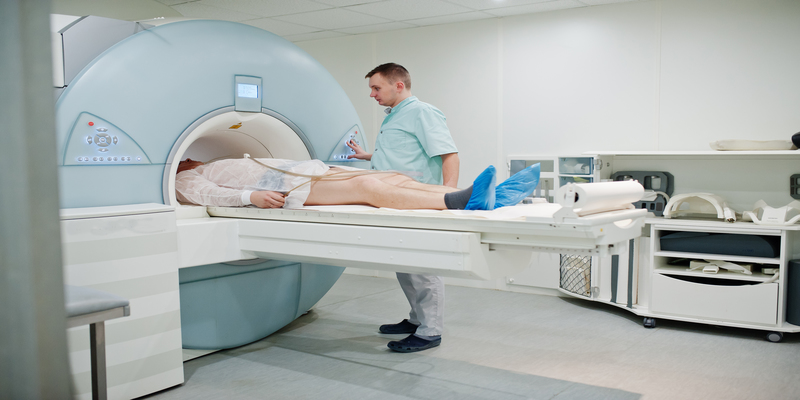If your doctor has told you that he or she is going to order an imaging scan, two of the most common options are X-rays and MRIs. They are very different scans, and they are used for different purposes. What do you need to know about X-rays and MRIs? How are they different from each other?

How Does an X-Ray Generate its Image?
First, it is important to take a look at how each scan generates an image. An x-ray uses small beams of radiation to generate an image. Radiation passing through different surfaces based on how dense they are. X-rays pass through solid media more quickly than liquid or air. Therefore, solid material shows up white on an X-ray, whereas lighter material shows up dark. That is why bone shows up light on an x-ray while soft tissue and liquid in the body appear darker.
How Does an MRI Generate its Image?
An MRI does not use any radiation to generate an image. Instead, and MRI uses powerful magnets to generate imaging scans. When this magnet is turned on, nuclei in the body will spin in different directions. Based on how these nuclei spin, an MRI scan will generate images differently. Therefore, even though two materials may have similar densities, they may show up differently on an MRI scan if their nuclei are spinning in different directions.
Why Might a Doctor Order an X-Ray?
An x-ray is one of the fastest imaging scans. Therefore, a doctor will commonly order an X-ray in an emergency situation. One of the most common reasons why a doctor may order an X-ray is if he or she suspects a bone fracture. Because an x-ray is great at showing dense, hard bone against soft tissue, this is one of the top scans to detect bone fractures.
Doctors may also decide to order an X-ray if they suspect kidney stones, skull injuries, or gallstones. Because these scans usually involve looking at hard items and surfaces, x-rays are good choices.
Why Might a Doctor Order an MRI?
An MRI takes much longer to complete; however, it does produce a much more detailed image. Therefore, if time is not a major factor, a doctor may order an MRI to produce a more detailed image. Doctors commonly order MRIs if they suspect soft tissue injuries, as these do not show up as well on x-rays. For example, if a doctor is looking for a ligament tear, an MRI may be ordered. Or, if a doctor is trying to get a closer look at the structure of the brain, he or she may order an MRI for this scenario as well. An MRI is commonly ordered for possible organ injuries as well.
What Are the Advantages of an X-Ray?
There are several major advantages of ordering an x-ray. These include:
- An x-ray is one of the least expensive imaging scans available
- It is one of the fastest imaging scans, making it great for emergency situations
- It does a great job at producing an image of solid surfaces against softer backgrounds
- The amount of radiation produced by an x-ray is relatively small
Because of these advantages, doctors order x-rays relatively frequently.
What Are the Advantages of an MRI?
There are several advantages of ordering an MRI as well. These include:
- An MRI produces one of the most detailed images available
- There are numerous imaging options available for an MRI, such as ordering an MRI with contrast, allowing a doctor to tailor the MRI to meet his or her needs
- An MRI does not use any radiation at all
- An MRI has a very versatile imaging scan that can be used in a wide variety of situations
Doctors commonly order MRIs when they require a very detailed image.
What Are the Disadvantages of an X-Ray?
There are several disadvantages of using an x-ray as well. These include:
- Even though the amount of radiation is relatively low, there is still radiation present during the scan
- An x-ray is not great at showing ligaments, soft tissues, and muscle tendons
- If there is any metal present, it can significantly distort the x-ray image
These disadvantages have to be weighed against the benefits before making a decision.
What Are the Disadvantages of an MRI?
There are several disadvantages of ordering an MRI scan as well. These include:
- An MRI scan takes a long time to complete, so it may not be appropriate for emergencies
- People often have a hard time holding still for the entire procedure
- An MRI is very expensive
- If someone has metal present inside of his or her body, he or she cannot get an MRI scan
Even though these drawbacks can be significant, an MRI produces a very detailed image that can be helpful in certain situations.
Learn More About Imaging Scans from Dr. Wagner
These are just a few of the most important points that everyone should keep in mind when it comes to imaging scans. In addition to x-rays and MRIs, doctors may also order CT scans, ultrasound images, or PET scans. If you have an imaging scan coming up, you need to know what to expect. That is where we can help you. If you have been hurt in an accident and you have imaging scans coming up, we are here to help you. At Doctor Wagner, we always place the needs of our patients ahead of our own. We would be happy to help you as well. Please contact us today to make an appointment!
